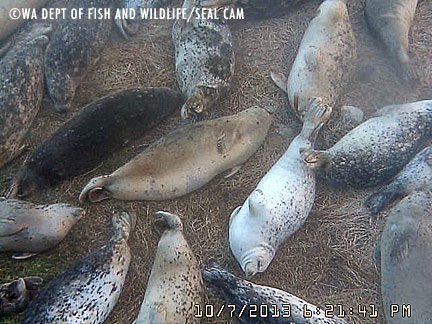Oct 2013
Trio of pups delight volunteers and public
Oct/30/13 08:10 AM
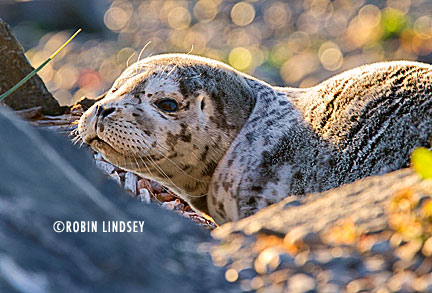
Doc returned like clockwork to his favorite hideout and volunteers stayed throughout the day to talk with the occasional beachcombers strolling this stretch of beach, many with dogs. At sunset, Doc flopped back across the sand and headed out for some dinner entree choices of shrimp, squid or small bait fish. We expect to see him again today.
We received a report about 3pm of a seal pup on the beach near Colman Pool at Lincoln Park. The reporting party said people were too close, letting their leashed dogs bark at the pup and wanting to touch him. When our responder arrived, she coaxed the crowd away and set up a quick tape perimeter. The pup was only feet from the sidewalk, but we tried to give him as much of a buffer zone as possible. A family with several young girls were transfixed and given naming honors for being so respectful. One of the youngsters named the pup Shitake (shown above), meaning forest mushroom. Tucked in the logs and rocks, Shitake managed to get a bit of rest in spite of the soft murmur of voices from the sidewalk above. The quietly observant public was enthralled by this little pup’s presence. Shitake returned to the Sound to forage just as the sun was setting and volunteers returned home to forage for some dinner of their own.
Volunteers make daily trip to see Doc
Oct/29/13 08:32 AM
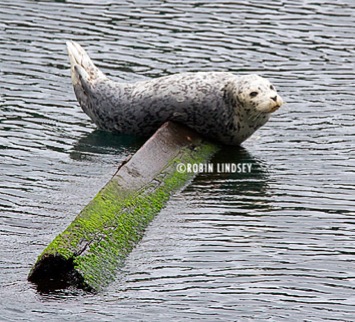
This past week, we also responded to a dark-coated pup at Lincoln Park, who seems to haul out at the end of the day when the park is quieter and less vulnerable to disturbance from people and injury from dogs. As weaners get older, they also get wiser, more wary and are able to better assess risks.
Each day for almost a week now, a small pup has been coming ashore on a private stretch of beach with public access at low tide. Because this beach is notorious for off-leash dogs, we have had a volunteer presence to ensure that “Doc” can rest safe and sound in his secret hideaway. While people passing by might not notice him, dogs with their excellent sense of smell and curiosity definitely would, putting the pup (and dogs) in possible danger. Thanks to the volunteers who have done some mighty cold duty looking after Doc.
Fishing gear - and feeding - a grave danger to seal pups
Oct/26/13 08:22 PM
Yesterday afternoon, we received the necropsy report from WDFW-MMI on seal pup Solo. The very small pup with a traumatic eye injury was rescued from Don Armeni public boat launch Tuesday night, but was euthanized Wednesday at PAWS Wildlife Center. The necropsy revealed that Solo’s right eye had been punctured, possibly from a fish hook, which had caused a significant infection inside the pup’s head. Other potential causes could be a bite from a dog or other seal, but there would have been evidence of other wounds or bruising of tissue around the eye socket - and there was none. It’s estimated the wound was inflicted about 5 days prior.
Since the area around the boat ramp is frequented by fishermen casting from both shore and the fishing piers, this would seem a very probable cause. One morning, much to the distress of one of our volunteers, a fisherman insisted on casting out among seal pups who were foraging close to shore. West Seattle is a daily destination for many fishermen who can be seen all along the shoreline from Jack Block Park to Lincoln Park.
DO NOT FEED SEALS AND SEA LIONS - IT IS AGAINST FEDERAL LAW
Some fishermen will toss bait to seals thinking it will keep them satisfied and less inclined to steal their bait or catch. This is far from the truth. A seal that has been fed will actually seek out humans because it learns to associate humans with easy meals and, consequently, become conditioned to not hunt on his own. Pups learn to be attracted to fishing piers and docks and they will sometimes steal from a fishing line. Needless to say, that does not endear them to fishermen, some of whom may even retaliate. It is dangerous on so many levels. Seals can swallow deadly lures or become entangled in derelict line. At marinas and boat launches, it makes them vulnerable to propeller strikes or being run over by boat trailers. Encouraging pups to hang out in these areas can often have disastrous results - as it apparently did for Solo.
If you’re fishing in an area and a seal is hanging out, take a break and the seal will most likely move on. Please use barbless hooks to reduce the chance of harming them. Make sure all derelict line and gear is removed from beaches and piers. Fish should be cleaned at designated cleaning stations - not on the docks - and scraps should be discarded per regulations. Don’t dump your leftover bait near marina docks or popular fishing spots. You will only be encouraging seals’ unwanted behavior.
Unfortunately, not everyone who purchases bait at local shops does so for fishing purposes. Instead, they feed seals from docks and piers. This can be dangerous not only for seals and sea lions, but for people, too. In Victoria, BC, a young child was pulled into the water by an adult seal as her father cleaned fish on a dock popular for feeding them. Several locations in Victoria irresponsibly promote seal feeding as an attraction. The outer coast of Washington has several marinas where sea lions have become a nuisance because people feed them. Since they have learned to associate people with fish, the sea lions have actually ripped fish from people walking along the dock. An Everett, WA, boat launch has a similar problem with harbor seals. It is only a matter of time before someone is hurt - and, of course, the seals and sea lions will unfairly bear the blame and punishment. DO NOT FEED MARINE MAMMALS. Not only is it illegal (the Marine Mammal Protection Act forbids it) - you are putting both marine mammals and people at risk.
Solo was a very tiny male pup, measuring only 71 cm (90 cm is average length of a newly weaned pup). It is thought that he might have been a lanugo pup, born prematurely. Even if her pup is born early, a seal mom will still only nurse for 4-6 weeks. After that, she needs to replenish her own fat stores.
Since the area around the boat ramp is frequented by fishermen casting from both shore and the fishing piers, this would seem a very probable cause. One morning, much to the distress of one of our volunteers, a fisherman insisted on casting out among seal pups who were foraging close to shore. West Seattle is a daily destination for many fishermen who can be seen all along the shoreline from Jack Block Park to Lincoln Park.
DO NOT FEED SEALS AND SEA LIONS - IT IS AGAINST FEDERAL LAW
Some fishermen will toss bait to seals thinking it will keep them satisfied and less inclined to steal their bait or catch. This is far from the truth. A seal that has been fed will actually seek out humans because it learns to associate humans with easy meals and, consequently, become conditioned to not hunt on his own. Pups learn to be attracted to fishing piers and docks and they will sometimes steal from a fishing line. Needless to say, that does not endear them to fishermen, some of whom may even retaliate. It is dangerous on so many levels. Seals can swallow deadly lures or become entangled in derelict line. At marinas and boat launches, it makes them vulnerable to propeller strikes or being run over by boat trailers. Encouraging pups to hang out in these areas can often have disastrous results - as it apparently did for Solo.
If you’re fishing in an area and a seal is hanging out, take a break and the seal will most likely move on. Please use barbless hooks to reduce the chance of harming them. Make sure all derelict line and gear is removed from beaches and piers. Fish should be cleaned at designated cleaning stations - not on the docks - and scraps should be discarded per regulations. Don’t dump your leftover bait near marina docks or popular fishing spots. You will only be encouraging seals’ unwanted behavior.
Unfortunately, not everyone who purchases bait at local shops does so for fishing purposes. Instead, they feed seals from docks and piers. This can be dangerous not only for seals and sea lions, but for people, too. In Victoria, BC, a young child was pulled into the water by an adult seal as her father cleaned fish on a dock popular for feeding them. Several locations in Victoria irresponsibly promote seal feeding as an attraction. The outer coast of Washington has several marinas where sea lions have become a nuisance because people feed them. Since they have learned to associate people with fish, the sea lions have actually ripped fish from people walking along the dock. An Everett, WA, boat launch has a similar problem with harbor seals. It is only a matter of time before someone is hurt - and, of course, the seals and sea lions will unfairly bear the blame and punishment. DO NOT FEED MARINE MAMMALS. Not only is it illegal (the Marine Mammal Protection Act forbids it) - you are putting both marine mammals and people at risk.
Solo was a very tiny male pup, measuring only 71 cm (90 cm is average length of a newly weaned pup). It is thought that he might have been a lanugo pup, born prematurely. Even if her pup is born early, a seal mom will still only nurse for 4-6 weeks. After that, she needs to replenish her own fat stores.
Seal pups galore on West Seattle shores
Oct/24/13 11:53 PM
It’s been a crazy week so far for Seal Sitters. On Tuesday, volunteers responded to reports of 4 harbor seal pups in varying locations in West Seattle. First responders and volunteer scheduler Connie all scrambled to ensure that they were kept safe. The last call of the day came into the hotline around 6:15 of a pup at Don Armeni Boat Launch. Unfortunately, when responders arrived they found a seal pup having seizures at the tideline. The pup was carried up onto the beach and a quick exam in the darkness revealed that he was suffering from a traumatic head injury. Evidently, the pup had been sighted at the ramp around 4pm, but no call was made to Seal Sitters dedicated hotline for over two hours. By the time we received a report, arriving at the ramp only minutes later, PAWS Wildlife Center had already closed for the night, leaving no option for treatment until morning. The pup, nicknamed Solo, was moved to a secure, warmer location and taken to PAWS early yesterday morning. Sadly, the pup had to be humanely euthanized by the attending vet. A necropsy will be conducted on the small, male pup.
This is a reminder to please call us immediately upon encountering a seal pup or other marine mammal on the beach. If you have a smart phone, but can’t remember our hotline number (206-905-7325: we suggest folks enter it into their cell phones), even a simple web search for “seal pups Seattle” will bring up our website.
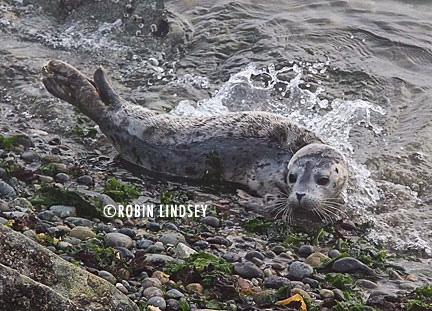 Yesterday, another 4 pups (seemingly different ones) were spread out in the four corners of West Seattle. Shown here, seal pup Harley is reluctant to return to fog-cloaked Puget Sound at high tide, even after resting for many hours. Harley has good body weight, but some wounds on his rear flippers.
Yesterday, another 4 pups (seemingly different ones) were spread out in the four corners of West Seattle. Shown here, seal pup Harley is reluctant to return to fog-cloaked Puget Sound at high tide, even after resting for many hours. Harley has good body weight, but some wounds on his rear flippers.
Just as darkness fell and the fog continued to thicken, the hotline fielded a report that a pup had hauled out at Lincoln Park. Due to safety concerns for volunteers after dark in the remote park, there was no response. However, later in the evening we responded to and taped off a pup in another location, one highly vulnerable to people and off leash dogs. During the night someone tore the tape, breached the perimeter and was coming up the beach stairs when our responder arrived. He said he “didn’t know” there was a seal on the beach despite “do not enter” and “harbor seal pup resting here” signs clearly posted with tape and barricades. Thankfully, our responder saw that the pup was still sleeping on shore and repaired the tape.
Today, in stark contrast, there were no pups on shore that we know of, as responders did routine checks of the shoreline throughout the day and evening.
This is a reminder to please call us immediately upon encountering a seal pup or other marine mammal on the beach. If you have a smart phone, but can’t remember our hotline number (206-905-7325: we suggest folks enter it into their cell phones), even a simple web search for “seal pups Seattle” will bring up our website.

Just as darkness fell and the fog continued to thicken, the hotline fielded a report that a pup had hauled out at Lincoln Park. Due to safety concerns for volunteers after dark in the remote park, there was no response. However, later in the evening we responded to and taped off a pup in another location, one highly vulnerable to people and off leash dogs. During the night someone tore the tape, breached the perimeter and was coming up the beach stairs when our responder arrived. He said he “didn’t know” there was a seal on the beach despite “do not enter” and “harbor seal pup resting here” signs clearly posted with tape and barricades. Thankfully, our responder saw that the pup was still sleeping on shore and repaired the tape.
Today, in stark contrast, there were no pups on shore that we know of, as responders did routine checks of the shoreline throughout the day and evening.
Weather cools down, but seal pup activity heats up
Oct/17/13 07:25 PM
Just as fall weather has turned very brisk, so has the number of seal pup responses along West Seattle’s shoreline. There has been a noticeable increase in activity the past week or so. According to Seal Sitters volunteer Richard, an avid diver, he has been seeing more bait balls of the small forage fish that are indispensable to the marine ecosystem and a favorite food of seal pups (read more about forage fish here). Last evening until just after dark, Richard and fellow volunteer Suzanne looked over new pup Humphrey who snoozed below Beach Drive. A very tiny pup, Humphrey could stand to snack on some of those fish and pack on some blubber to keep him warm in Puget Sound’s frigid waters. He returned to the water sometime overnight.
Seal pup Tiger continues his/her routine of hauling out just around dark every evening on the Elliott Bay side of West Seattle. He is thriving and it is a joy for volunteers to see such a seemingly healthy, vigorous pup. Tiger does seal pup yoga on the smooth beach sand, stretching his tail high and curving his body into a “u” shape - the classic “banana pose”. This behavior is his way of circulating warmth - or thermoregulating his temperature.
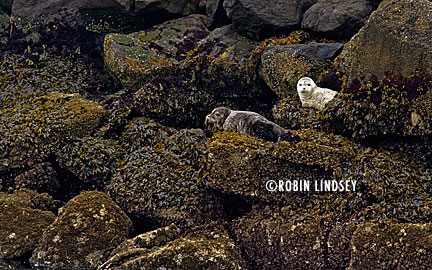 On a somewhat unusual note, for the past two days (possibly more that we were unaware of) pups have been hanging out together on the rocks along one of the sea walls. These young harbor seals come in at high tide during the night and are left quite vulnerable resting on the jagged rocks far above the water level, where they wait for the tide to return.
On a somewhat unusual note, for the past two days (possibly more that we were unaware of) pups have been hanging out together on the rocks along one of the sea walls. These young harbor seals come in at high tide during the night and are left quite vulnerable resting on the jagged rocks far above the water level, where they wait for the tide to return.
Each morning, responders have taped off the area above them so that they can rest undisturbed and not be at risk for fall and potential injury. Despite this, on Tuesday morning a woman went under the tape clearly marked with a “Do Not Enter” sign, standing a few yards from the pups and refused to leave, asking what harm she was doing. We tried to explain to her that there was a very real danger to these pups if they were scared and tumbled down 15 feet of craggy rocks with deep holes (seal pups Henry and Spanky fell deep into holes in past seasons).This is, of course, beside the fact that going under the tape and disturbing a maine mammal is breaking a federal law, the Marine Mammal Protection Act (read more here). It was quite sad that this woman created a contentious scene over our efforts to give these pups some rest. The pups could easily be seen from a sidewalk viewpoint and the posted signs explained that seal pups need undisrupted, stress-free rest to survive against challenging odds - a 50% mortality. People standing too close is most definitely a source of stress, which has been proven in many studies to negatively impact health in humans and animals. Thankfully, unpleasant incidents are rare. Most people are thrilled and empowered to be able to help a pup survive by simply giving them space.
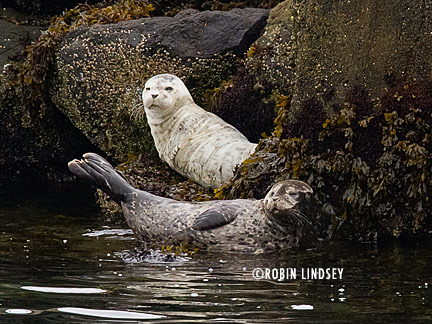 Volunteers set up a viewing scope so that the public could get an exceptionally close view of the pups, one with a beautiful light coat and the other with luxurious dark fur. It was a fantastic opportunity for passersby to learn about seal pup biology and behavior. The two pups returned to Elliott Bay mid-afternoon Tuesday when the tide finally reached them (photo right). The body weight of these two weaner pups seems to reflect that there is indeed more of a food source out there and we’ve observed quite a few pups fishing offshore. Most often, a pup will haul out close to where he is foraging.
Volunteers set up a viewing scope so that the public could get an exceptionally close view of the pups, one with a beautiful light coat and the other with luxurious dark fur. It was a fantastic opportunity for passersby to learn about seal pup biology and behavior. The two pups returned to Elliott Bay mid-afternoon Tuesday when the tide finally reached them (photo right). The body weight of these two weaner pups seems to reflect that there is indeed more of a food source out there and we’ve observed quite a few pups fishing offshore. Most often, a pup will haul out close to where he is foraging.
Yesterday morning before dawn, two light-coated pups were resting in almost the same spot. Unfortunately, as daylight increased, so did their nerves. The first jittery pup scooted back down the rocks to get to the water, tumbling the last few feet before landing in the bay with a big splash. This prompted the other pup to follow suit, disappearing in a watery splat.
These pups, only 2-3 months old, are now on their own with no adult to protect them. There is certainly safety in numbers for newly weaned pups; while one catches a snooze the other can be on the alert, providing a more satisfying rest. In all, Seal Sitters responded to 4 pups in West Seattle yesterday, with 3 the day before. We are comparing distinct markings to determine if the pups on the rocks are new visitors to our shores and will update Blubberblog with our findings.
Seal pup Tiger continues his/her routine of hauling out just around dark every evening on the Elliott Bay side of West Seattle. He is thriving and it is a joy for volunteers to see such a seemingly healthy, vigorous pup. Tiger does seal pup yoga on the smooth beach sand, stretching his tail high and curving his body into a “u” shape - the classic “banana pose”. This behavior is his way of circulating warmth - or thermoregulating his temperature.

Each morning, responders have taped off the area above them so that they can rest undisturbed and not be at risk for fall and potential injury. Despite this, on Tuesday morning a woman went under the tape clearly marked with a “Do Not Enter” sign, standing a few yards from the pups and refused to leave, asking what harm she was doing. We tried to explain to her that there was a very real danger to these pups if they were scared and tumbled down 15 feet of craggy rocks with deep holes (seal pups Henry and Spanky fell deep into holes in past seasons).This is, of course, beside the fact that going under the tape and disturbing a maine mammal is breaking a federal law, the Marine Mammal Protection Act (read more here). It was quite sad that this woman created a contentious scene over our efforts to give these pups some rest. The pups could easily be seen from a sidewalk viewpoint and the posted signs explained that seal pups need undisrupted, stress-free rest to survive against challenging odds - a 50% mortality. People standing too close is most definitely a source of stress, which has been proven in many studies to negatively impact health in humans and animals. Thankfully, unpleasant incidents are rare. Most people are thrilled and empowered to be able to help a pup survive by simply giving them space.

Yesterday morning before dawn, two light-coated pups were resting in almost the same spot. Unfortunately, as daylight increased, so did their nerves. The first jittery pup scooted back down the rocks to get to the water, tumbling the last few feet before landing in the bay with a big splash. This prompted the other pup to follow suit, disappearing in a watery splat.
These pups, only 2-3 months old, are now on their own with no adult to protect them. There is certainly safety in numbers for newly weaned pups; while one catches a snooze the other can be on the alert, providing a more satisfying rest. In all, Seal Sitters responded to 4 pups in West Seattle yesterday, with 3 the day before. We are comparing distinct markings to determine if the pups on the rocks are new visitors to our shores and will update Blubberblog with our findings.
Finally - a chubby seal pup to lift volunteers' spirits
Oct/12/13 10:23 PM
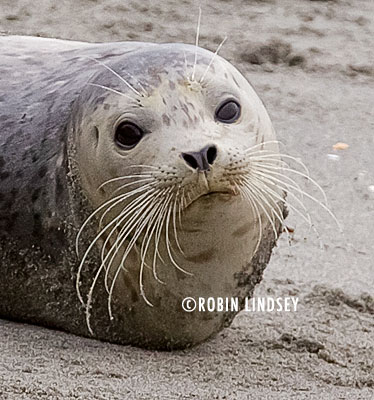
Tiger shows off a magnificent set of whiskers which he will shed next year during his first molt. Since newborn harbor seal pups shed a long and wavy white lanugo coat inside the womb (unless born prematurely), he will not be molting his new spotted fur until next season. However, once a pup reaches a year old, he will shed all his fur and whiskers (called vibrissae) annually over a period of one-two months immediately following breeding season. It takes many months for the whiskers to reach full length again. Seals do use their vibrissae to help them locate and identify prey by sensing motion, but during the very uncomfortable molt they tend to stay onshore for the most part and rely on fat storage for energy. This is why it is critical for seals to bulk up before the late fall and winter months since their weight will drop during the molt.
Seal pups on shore briefly today and others hanging around
Oct/11/13 09:47 PM
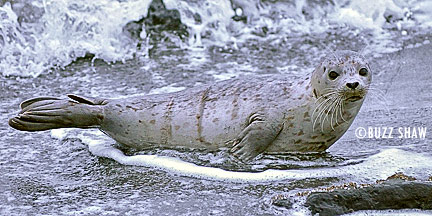
Later in the afternoon, 4 pups were observed foraging along the shoreline, but none that we know of came ashore. A pup was also sighted briefly on the protected beach at Jack Block Park. Perhaps the pups are resting at night or in locations that are less visible. The good news is, however, that we have pups still hanging around West Seattle and that they seem to be actively feeding. In the photo you can see Tiger’s long whiskers which detect vibrations from prey in the water. A recent study showed that the highly sensitive vibrissae contain thousands of nerves which enable a seal not only to locate prey, but determine size and species. This is why harbor seals are very effective hunters even at night or in deep, dark waters.
All of the harbor seal pups in South Puget Sound are now fully weaned. Almost all of the youngsters have left the relative safety of the rookeries to venture off on their own - and area haul-outs are full of grumpy adult seals, molting their coats and spending extended time on shore and less time feeding. While the molting process of harbor seals is not as grueling as the “catastrophic molt” of elephant seals, it is still a very trying time, particularly as winter months approach. Females who expended all of their resources to nurse pups for 4-6 weeks now face the additional physical stress of the molt. Thanks to WDFW-MMI for providing this seal cam photo of a freshly molted seal with a smooth new coat along with others who are still molting. Don’t forget to check out the WDFW seal cam webpage for a real-time look at a harbor seal haul-out and lots of informative articles and videos.
Haul-outs this time of year are not a welcoming place for new “weaners” to linger. All the more reason we need to offer them sanctuary on our urban beaches.
Seal pup warms hearts on chilly day
Oct/08/13 04:32 PM
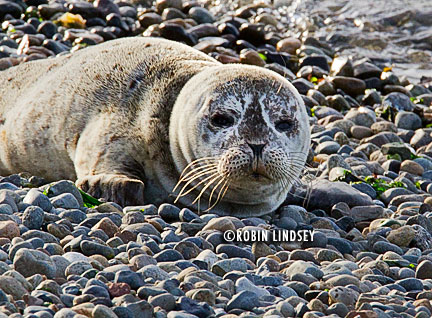
Volunteers kept watch over the pup throughout the afternoon into the evening as winds picked up and temperatures dropped. They talked to the public until around 6:30 pm when Tsuki finally stirred with the incoming tide and swam off in search of dinner. Like all of our pups this season, this little one really needs to fatten up and pack on some blubber for warmth and energy. We hope he (or she) was successful in foraging and have not seen Tsuki on shore yet today.
With too many pup deaths of late, it was good for enthusiastic volunteers (including youngsters Stella and Ruby - who also did her kindergarten homework while on duty) to be able to get back out on the beach and help a pup get some much-needed shut-eye.
Funding cuts a huge blow to Washington State marine mammals
Oct/04/13 02:54 PM
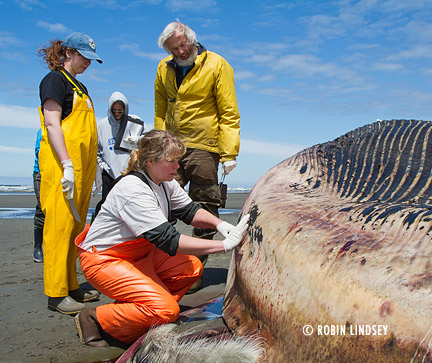
As a critical member of NOAA’s Northwest Marine Mammal Stranding Network, WDFW-MMI provides marine mammal response and triage to a wide geographic area, including both inland waterways and the outer coast of Washington. The public not only expects, but demands that marine mammals, alive or dead on the beach, be tended to (such as the fin whale shown here on an Ocean City beach in June). It puts both the animals and the public in danger if there is not a professional response to these strandings.
Washington State takes great pride in our marine mammals. We should take all necessary steps now and set aside Sate funding to ensure their protection, independent of Federal grants. The scientific work performed by WDFW-MMI is crucial to the health of marine mammals and of our State’s marine ecosystem. WDFW- MMI is one of the few organizations in place in Washington State to perform marine mammal necropsies. Most stranding networks in the Pacific Northwest turn to them for advice because of their decades of expertise and behavioral observations. The value of this collaborative relationship is incalculable. This “citizen science” mentoring of network volunteers across the region greatly assists the State in its work protecting marine wildlife.
The amount of research that has been performed by WDFW-MMI, often in conjunction with other members of the NWMMSN, is both impressive and important - from monitoring emerging disease in marine mammals to the devastating impact of contaminants. Their studies of harbor seals, a sentinel species, reveal the health of our marine ecosystem as a whole. Their 2005 study revealed that harbor seals in South Puget Sound were 7 times more contaminated with PCBs and other toxins than those living in Canada’s Georgia Strait. Without WDFW-MMI’s response, we would not have known that Guadalupe Fur Seals have returned to the outer coast of Washington after many decades of absence. We would not know of the transfer of land mammal diseases to marine mammals and other emerging zoonotic diseases. It is imperative that this work be funded and continue.
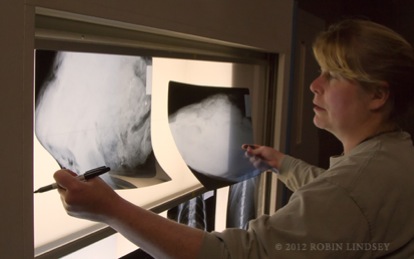
For the past 7 years, Dyanna and the WDFW-MMI team have provided immeasurable support to Seal Sitters MMSN. They have been our sole resource for necropsy to determine mortality of seal pups, adult seals and sea lions and harbor porpoise. She has generously mentored our network, sharing her knowledge and improving our ability to assess animals during response. Seal Sitters has now responded to 12 dead seal pups (2 today) this 2013 harbor seal pupping season - almost all of them horribly thin. Our official start date for pupping season in West Seattle was July 19th with a response to a stillborn pup at Harbor Island. This is the highest number of dead pups this early in pupping season in the years Seal Sitters has been responding to marine mammals. With WDFW-MMI resources no longer available for necropsy, we will have no means to determine cause of mortality of marine mammals - other than high profile whale strandings or, perhaps, shooting investigations.
What cannot be measured or replaced is the passion and leadership of Dyanna Lambourn. The interns (and future marine mammal biologists) studying under her get an intensive and unique opportunity for hands-on experience with marine mammals, learning biology and behavior. However, what cannot be taught is passion. Passion is inspired by leadership and example. There is no one in those categories who can surpass Dyanna Lambourn, whose interns work tirelessly, as she does, at her side.
STATE FUNDING SHOULD BE IN PLACE TO HELP MARINE MAMMALS
WDFW-MMI provides tremendous value to Washington residents, playing a pivotal role in protecting and preserving the marine wildlife we all treasure. Please contact your State representatives, State senators, and Governor Jay Inslee. Let them know that protecting our marine mammals is important to you. Request that the State set aside some funding so that this critical WDFW-MMI team can continue their research and support of other members of NOAA’s Northwest Marine Mammal Stranding Network. Please email WDFW’s Director - let him know that you care about marine mammals and that research and response should remain an integral part of WDFW’s work. Washington State should not depend on dwindling funds from the Federal Government to ensure our marine mammals are protected.
PRESCOTT GRANT FUNDS NEED TO REMAIN IN THE NATIONAL BUDGET
Federal Prescott funding for 2013 was slashed from roughly $4 million (with approximately 40 grants awarded annually to stranding networks across the country) to just over $1million - and only a dozen grants awarded this year for the entire nation. Read Wired Magazine’s report on the impacts of this decimated funding here.
To read more about how NOAA’s Marine Mammal Stranding Network depends on this funding for both response and research, click here. Contact your representatives in the US House of Representatives and US Senate - tell them marine mammals are important to you and insist that Prescott grant funding be included in the President’s 2014 FY Budget. This tiny part of the many billion dollar Federal budget is in jeopardy of disappearing entirely in the near future. We need to act now to ensure critical research and protection of marine mammals!
